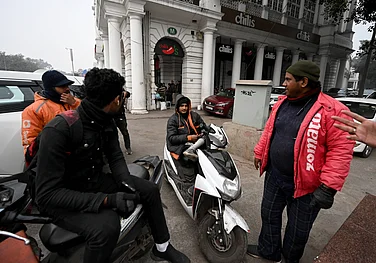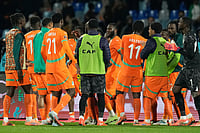Should we or shouldnt we go in for a hot pursuit in Kashmir?Thats the debate currently going on at the policy-making levels. Its apremature debate, because that final stage of decision making is one that a country getsto by first passing through the earlier stage of can we? And we have not gonethrough this stage. Sadly enough, a declaratory debate is predating a serious tactical andstrategic analysis. Here Israel - a model country when it comes to operations less thanwar (oltw) - is an example. Lets run through what the Indian policy-maker imaginesgoes on in Israel.
An Israeli kibbutz on the Lebanon border is going through its annual Jaffa orangeharvest. Students have come from the cities to help pick oranges. Truckloads of orangesreturn to the kibbutz every day accompanied by a busload of orange-picking volunteers. Onthe second day at sunset, the bus is blown up while passing over a culvert. The Israelicabinet sits at 2000 hrs after alerting the army and air force. A retaliatory strike isauthorised at 2200. Night-flying commando helicopters take off before dawn, with landlaser designator-carrying commando teams who illuminate the local headquarters of theHezbollah. Strike fighters follow and drop laser-guided bombs on the designated target.The commandos follow up with manually placed explosives, returning to base by 0600 hrs.Plenty of political resolve. If only we had the same, right?
Wrong. The actual narrative runs something likethis: Israeli intelligence wouldve reported months earlier that a big operation wasbeing planned somewhere on the northern border. They wouldve positioned an aerostatballoon crammed with electronic equipment to listen to all frequencies on the border.Satellite eavesdropping would concentrate on the same area. Israeli air force jets wouldoverfly the area in broad daylight (down the airspace legalities) and obtain 10 cmresolution photographs. All this while, its to be borne in mind that no amount oflegal interpretation is going to ease the policy-makers dilemma of arriving at adecision. The legal pundits will simply have to control the damage and carry outfire-fighting along with a skilled PR offensive once a policy decision is made to exercisehot pursuit. The Hezbollah HQ would be located and a model built in Israel. Tacticaltraining of strike fighters, commando teams, night-flying helicopters and communicationsstaff would commence. Headquarters staff of the services would write out thescenario arising from a terrorist strike and an Israeli retaliatory strike.Where could the whole thing go? In which directions could the chain of events lead? Whatinternational fire-fighting, or military escalation would it entail? So finally, when theterrorist strike occurs the cabinet wouldnt sit around a table drinking tea,theyd be told what the Israeli forces can do, and perhaps more importantly what theycant do. The politicians would be briefed on the wider implications whichwouldve been arrived at by war-training. This might reveal dangers far greater thanthe domestic political advantages of an immediate retaliation. In which case things mightbe rescheduled and retaliation would no more be hot pursuit.
Maybe the hot pursuit may never occur for a couple of years, because the combinedforces of national intelligence, surveillance assets and the armed forces cannot think upan appropriate retaliatory strike that meets the immediate situation. There is nothingworse than an aimless bombing attack on a terrorist camp across the LoC that doesntsend out the intended signals and kills aimlessly. Hot pursuit is certainly not apolitical activity, but one of those oltws limited in scope, area and objective. In thatsense its not a no-holds-barred military operation, but an operation circumscribedby these three factors. A cross-border operation across the LoC is going to need prettyaccurate intelligence, on the outfit that is to be struck, where its leaders are, whetherenough trainees are present in the camp and the level of state support that it enjoys. Allthis is possible, but the military with its present higher organisation and command isunsuited to either make the assessment or practice such an operation. Legally, hot pursuithas no clear basis in international law or the Geneva conventions. Its one of thoserights that strong powers confer upon themselves like exclusion zones and no-fly-zones.The omnibus clause used to justify these actions is the article justifying self-defence.
The operation wouldve uavs overflying the area every night with thermal imagingequipment keeping a lookout for hotspots. Night-flying helicopter squadrons would obtainterrain configuration maps and fly simulation flights to imaginary targets on simulators.India, unlike Israel, is geographically too big for hot pursuit to be planned in thecapital. Delhi may retain the right to veto an operation after its scope is explained bythe local command. To enable the command in Srinagar or Udhampur to plan and execute anoperation in real time, the command facilities will need upgrading and integration of bothintra-service and between the service and civilian agencies. Then again, overhauling ofthe command organisation and the political go-ahead for hot pursuit wont necessarilymean immediate action or immediate success. But the process will begin.
This is one instance where Delhi isnt directly to blame. The armed forces mustget their act together and set up a proactive inter-services planning staff backed byadequate technology. They must create options which look beyond the LoC, butdo so with politico-military sensitiveness. And that level of complex planning is what canbe expected from an army command that controls the outputs of half-a-million men. What isbeing asked of Northern command isnt just structural reorganisation to preventKargils, but to create viable cross-border options for the pmo to consider.
(Raja Menon, a former naval officer, writes on strategic affairs.)






















